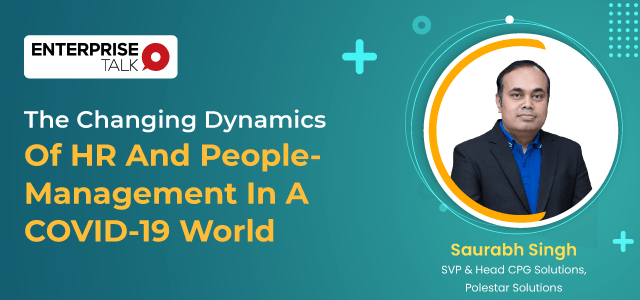The Changing Dynamics Of HR And People-Management In A COVID-19 World :
Originally Postted: Enterprisetalk
Saurabh Singh: Enterprises often have practiced for measuring employee performance and have a certain set of initiatives to encourage employees through various R&R schemes. But often, these practices are worked out through a very siloed approach, and the final say is not completely objective—this where a good people-analytics practice comes in.
With work dynamics have changed so rapidly, companies are beginning to realize the importance of having integrated HRMS tools, along with interactive analytics dashboards, to help provide insights on workforce data points, in turn, helping companies improve the role of their current HR processes.
Additionally, in the context of a remote working environment, there are strong indications that businesses will soon move towards flexible working models, wherein sections of their workforce will juggle time spent between the office and their respective homes. In such a scenario, HR analytics dashboards help make sense of HR metrics, thereby improving everything from recruitment processes to managing and enhancing employee performance. It helps organizations use interactive data visualizations to make informed, data-driven decisions.
ET Bureau: With people-analytics becoming a priority for organizations in a COVID-19 world, how can companies leverage their data sources to make the right decisions?
Saurabh Singh: While taking data sources into consideration, we often look at internal parameters such as performance management, rewards, and recognition, salary history, demographics, employee/ engagement surveys, traditional financial data, etc. as starting points to enable us to make data-driven decisions, however, we often ignore external sources of data.
This refers to externally existing data sought through external surveys and other sources such as social media, content platforms, benchmarking data, etc. which provide crucial insights on employee engagement, effectiveness, comparison of band/salary vis-a-vis peer companies, and even productivity.
The other aspect to consider is that we need to start moving away from siloed data towards cross-company or cross-functional analysis to provide a greater degree of confidence to decision-makers.
Broadly, people or HR analytics provides integrated data from multiple sources, enables a 360-degree view of employees, and provides one version of the truth. Together, internal and external data, enterprise data, and structured, semi-structured, and unstructured data can help companies use real-time analytics to take immediate action and make smarter decisions in areas such as upskilling of the workforce, hiring-to-retention of top-tier talent, and extending it to create a more engaged workforce.
ET Bureau: “A 2015 Deloitte survey found that 75% of companies believe that using people analytics is essential. However, only 8% believe that their organization is strong in this area.” Can you comment on this gap, whether you believe this has been fixed, and some of the challenges companies still face today?
Saurabh Singh: One of the biggest reasons as to why the adoption of statistical insights and data analytics to make talent management decisions was so low a few years ago was that most companies had a narrow approach to adopting data analysis. Many organizations were also stuck with outdated ways of churning out the same metrics that had been around for decades.
The challenge for HR functions is to ask the right strategic questions to help identify metrics that can help implement company-wide HR strategies. I think it is important to figure out the pain points companies are facing and identify ways to mitigate those risks and challenges. Over the past couple of years, companies have started realizing the importance of HR metrics to help anticipate risks, make bold strategic decisions, and better prepare for the future of the workplace and workforce.
Companies need to look at the current issues from the perspective of process and data while keeping in mind the existing technology landscape, considering the speed to market and rolling out initiatives in a phased manner.
The implementation phase has to run simultaneously with a change management stream. A well-defined change strategy is one where key evangelists are identified and persona specific training is done. There should also be a feedback mechanism put in place, which functions both ways, i.e., feedback for trainers, the training as well as evaluation for users. Finally, organizations should look at sustaining this through the internal center of excellence (CoE), which can be different for different organizations; centralized, decentralized, or on-demand.
Big data and analytics have become increasingly powerful tools in recent times, helping businesses measure effectiveness, and this is no different for the function of HR. The future of HR is looking towards people analytics and how it can help companies focus on workforce management and use its influence to positively impact business processes holistically.
